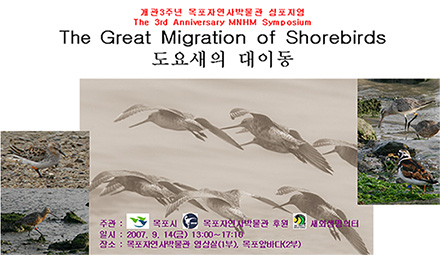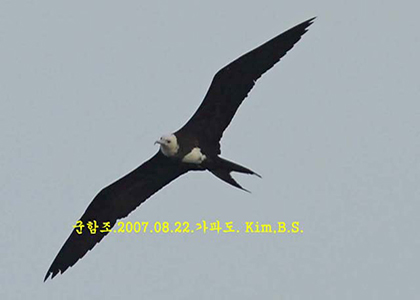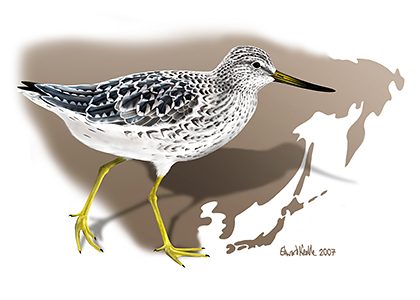This Update covers August 1st - August 30th 2007. It is in three parts:
An outbreak of disease, suspected at present to be a form of avian botulism, killed in excess of 5,000 Black-tailed Gull Larus crassirostris and much smaller numbers of other species at the Geum Estuary between 17th and 20th August. There is, however, slightly better news concerning domestic attitudes towards Highly Pathogenic (HP) H5N1 Avian Influenza (AI), the devastating disease best considered as “Poultry Flu.” A report produced by the Food and Agricultural Organisation (FAO) after their investigations of the South Korean outbreaks in December 2006 has recently been made available to Birds Korea (posted at: CMC Mission Report ROK). While correctly commending the government of South Korea for their great efforts in tackling HP AI outbreaks, the FAO report also makes clear that there was, as reported previously on our websites (e.g. at: http://www.birdskorea.org//Our_Work/H5N1/BK-H5-NM-Review-of-evidence.shtml), zero evidence of transmission of the virus from wild birds to poultry (or happily even from poultry to wild birds) connected to these Korean outbreaks. There was, however, clear evidence of introduction of the virus into Korea through import in an earlier outbreak. With this more sensible and rational background for discussion now being heard by decision-makers, we believe that future Poultry Flu outbreaks can be better understood and reported, with fewer threats (direct and indirect) to wild bird populations as a result.
As disease does remain a major concern, however, those finding dead or dying birds in Korea are kindly urged to contact wildlife veterinarian Dr. Kim Youngjun for advice (ecovet@yahoo.co.kr), and Birds Korea for assistance.
Not disease, but tidal-flat reclamation remains the most serious threat to Korea’s internationally important bird species. A recent paper published by Goss-Custard and colleagues (in Ecological Applications 16 (6):2215-2222) matches shorebird population decline models with loss of habitat in the UK caused by a minor reclamation – helping to demonstrate that mortality of shorebirds displaced by reclamation rises as a result of increased competition between birds combined with the reduced amount of available prey. With the loss of feeding habitat for probably 400,000 shorebirds at Saemangeum alone, the impacts on the Flyway’s shorebirds of large-scale reclamation are both enormous and long-term, likely to lead to some species’ likely extinctions. For one graphic example, unpublished survey work of the Spoon-billed Sandpiper Eurynorhynchus pygmeus in 2006/2007 now suggests that the population of this species might have fallen even further than previously suspected: down from an estimate of only ca 350 pairs remaining in 2006, to possibly only 100 remaining breeding pairs in 2007. Whatever the precise number remaining, the Spoon-billed Sandpiper is clearly now threatened with imminent extinction due to a range of factors, including the loss of Saemangeum, as well as the degradation of other key sites like the Nakdong Estuary. Clearly, this charismatic and highly specialized shorebird should best be considered Critically Endangered. Two immediate steps that need to be taken to halt its precipitous decline include restoring some of the tidal-flow to Saemangeum, and fully protecting the Geum Estuary: possibly now the world’s most important remaining staging site for the species.

the magazine of the Royal Society for the Protection of Birds RSPB.
If you have not yet done so, we therefore urge all our members to please voice your concerns through the dedicated website run by Ricki Coughlan: www.restoresaemangeum.com
And please pass on this URL to others, through email and listservers.
August was a month of largely behind-the-scenes work, on both the English-language website (many thanks again to lifetime member Andreas Kim in Mokpo and Lydia Slobodian) and on a revised Birds Korea Checklist (with input from both overseas and in Korea).

Despite this somewhat quieter month, our work continues to be heard: major media coverage in August citing Birds Korea and the Saemangeum Shorebird Monitoring Program included a three-page article on the impacts of the Saemangeum reclamation in Australia’s leading news magazine (pages 30-32 of August’s The Bulletin with Newsweek), and also in the RSPB’s Birds magazine, which goes out to all of its 1.1 million members in the UK.
Work in September includes working with professional shorebird photographer Jan van de Kam (back in Korea for almost the whole month), gathering images for a Yellow Sea shorebird-book in preparation for next year’s Ramsar Convention conference (to be held in Changwon, October 28- November 4); participating in a shorebird exhibition and awareness-raising events in Mokpo (on the 14th); and conducting further media work and SSMP report writing, assisted by generous and essential funding support from the David and Lucile Packard Foundation and from the Takagi Fund for Citizen’s Science.

August remained largely hot or even very hot, with periods of rain from mid-month onwards.
Outstanding summer highlights included presumed breeding Light-vented Bulbul Pycnonotus sinensis on Socheong Island (for the third year in a row), with two “relatively young” juveniles seen there by Robin Newlin on 20th-21st, and in the south of the country successful breeding of Pheasant-tailed Jacana Hydrophasianus chirurgus at Joonam Reservoir (for some stunning images by Kim Ju-Heon, please go to: http://kwbs.or.kr/...). Another surprising breeding record comes from July, when Im Kwang-Wan photographed an exceptional mixed pair of Brown Lanius cristatus and Tiger Shrike L tigrinus feeding young, in Hanam City (see pictures here). This is the second such mixed pair noted between these species in Korea (see: Birds Korea 2005 review). August is increasingly recognized as an exciting month for seabirds and shorebirds in Korea and 2007 was no different, producing a juvenile (presumed) Great Frigatebird Fregata minor photographed on Kapa Island, Jeju by Kim Byung-Su on 22nd (which if the identification is confirmed would become only Korea’s second record).

In addition, there was an immature Lesser Frigatebird Fregata ariel photographed on Socheong Island on 18th (Nial Moores and Dennis Buss), probably about the 10th national record; an adult suspected Aleutian Tern Sterna aleutica, between Socheong and Incheon port on 20th (Robin Newlin); and a Long-billed Murrelet Brachyramphus perdix (either a juvenile or an adult in non-breeding plumage) seen from a different ferry the same day by Nial Moores, at approximately 37 D 30 N, 124 D 49 E. Especially scarce shorebirds in August included a Common Ringed Plover Charadrius hiaticula at Hongseong from at least 13th (photographed by Jo Seong-Sik), an Oriental Plover Charadrius veredus seen at Yubu Island on 16th (Nial Moores), 2 Spoon-billed Sandpiper Eurynorhynchus pygmeus there on 16th with 3 on 17th (Nial Moores, Ju Yong-Gi and Dennis Buss), and 2 Nordmann’s Greenshank Tringa guttifer at the threatened Song Do tidal-flat on 21st (Nial Moores and Dennis Buss).

Finally, a gentle reminder to all of our members, past and present, living in Korea. Birds Korea depends entirely on the support of our members and volunteers. Donations and domestic membership fees are vital to us! Please renew your membership (annual membership fee is only 30.000 Korean won; and life-time membership only 150.000 Korean won at this time), and help us to help the birds!
Birds Korea, August 31st, 2007.



